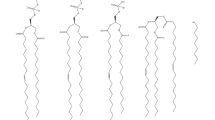Abstract
Incorporation of First-Order Uptake Rate Constants from Simple Mammillary Models into Blood-Flow Limited Physiological Pharmacokinetic Models via Extraction Efficiencies. W. L. Roth, L. W. D. Weber, and K. Rozman (1995). Pharm. Res. 263–269. First-order rate constants obtained from classical pharmacokinetic models correspond to mammillary systems in which all of the blood (or plasma) is assumed to be located in a central compartment. In such models the rate at which chemicals are transported out of this pool and into another compartment is the product of the mass of chemical in the central compartment multiplied by a rate constant, which is not limited in magnitude by the blood flow, or the rate at which chemicals from the blood are delivered to the peripheral compartment. Most of the physiologically-based models published to date dispense with some of the information available from mammillary models by assuming that all of the chemical delivered by the flow of blood rapidly equilibrates and can be taken up by the tissue under the control of a “partition coefficient” (Rij = Cj/Ci). We show that the partition coefficient alone does not retain the uptake rate (kji) information available from a classical mammillary model, but that the uptake rate information can be incorporated via unitless extraction efficiency parameters, εj.
Similar content being viewed by others
REFERENCES
M. Gibaldi and D. Perrier. Pharmacokinetics, 2nd edition, Marcel Dekker, New York, 1982.
L.E. Gerlowski and R.K. Jain. Physiologically based pharmacokinetic modeling: principles and applications. J. Pharm. Sci. 72(10):1103–1127 (1983).
F.F. Ferris, R.L. Dedrick, P.V. Allen, J.C. Smith. Physiological model for the pharmacokinetics of methyl mercury in the growing rat. Toxicol. Appl. Pharmacol. 119(1):74–90 (1993).
L.B. Kedderis, J.J. Mills, M.E. Andersen, L.S. Birnbaum. A physiologically based model for 2,3,7,8-tetrabromodibenzo-p-dioxin (TBDD) in the rat: tissue distribution and CYP1A induction. Toxicol. Appl. Pharmacol. 121:87–98 (1993).
C. Crone. Permeability of capillaries in various organs as determined by the use of the “indicator diffusion” method. Acta Physiol. Scand. 58:292–305 (1963).
E.M. Renkin. Transport of potassium-42 from blood to tissue in isolated mammalian skeletal muscles. Am. J. Physiol. 197(6):1205–1210 (1959).
C.A. Goresky, W.H. Ziegler, G.G. Bach. Capillary exchange modeling: barrier-limited and flow-limited distribution. Circ. Res. 27:739–764 (1970).
C.A. Goresky, G.G. Bach, B.E. Nadeau. On the uptake of materials by the intact liver. The transport and net removal of galactose. J. Clin. Invest. 52:991–1009 (1973).
L.W.D. Weber, S.W. Ernst, B.U. Stahl, K. Rozman. Tissue distribution and toxicokinetics of 2,3,7,8-tetrachlorodibenzo-p-dioxin in rats after intravenous injection. Fund. Appl. Toxicol. 21(4):523–534 (1993).
R.C. Boston, P.C. Greif, M. Berman. Conversational SAAM—an interactive program for kinetic analysis of biological systems. Computer Prog. Biomed. 13:111–119 (1981).
W.L. Roth, L.W.D. Weber, B.U. Stahl, K. Rozman. A pharmacodynamic model of triglyceride transport and deposition during feed deprivation or following treatment with 2,3,7,8-tetrachlorodibenzo-p-dioxin (TCDD) in the rat. Toxicol. Appl. Pharmacol. 120:126–137 (1993).
W.L. Roth, S. Ernst, L.W.D. Weber, L. Kerecsen, K. Rozman. A pharmacodynamically responsive model of 2,3,7,8-tetra-chlorodibenzo-p-dioxin (TCDD) transfer between liver and fat at low and high doses. Toxicol. Appl. Pharmacol. 127:151–162 (1994).
J.R. Pappenheimer. Passage of molecules through capillary walls. J. Clin. Invest. 33:387–423 (1953).
J.B. Bassingthwaighte. A concurrent flow model for extraction during transcapillary passage. Circulation Research 35:483–503 (1974).
C.A. Goresky, G.G. Bach, B.E. Nadeau. On the uptake of materials by the intact liver. The concentrative transport of rubidium-86. J. Clin. Invest. 52:975–990 (1973).
D.J. Bowsher, M.J. Avram, M.C. Frederiksen, A. Asada, A.J. Atkinson. Urea distribution kinetics analyzed by simultaneous injection of urea and inulin: demonstration that transcapillary exchange is rate limiting. J. Pharmacol. Exp. Ther. 230(2):269–274 (1984).
E.L. Forker, B.A. Luxon. Albumin-mediated transport of rose bengal by perfused rat liver. J. Clin. Invest. 72:1764–1771 (1983).
J. Dancis, V. Jansen, J. Kayden, L. Bjornson, M. Levitz. Transfer across human placenta. III. Effect of chain length on transfer of free fatty acids. Pediat. Res. 8:796–799 (1974).
L.A. Hillyard, C.E. Cornelius, I.L. Chaikoff. Removal by the isolated rat liver of palmitate-1-C14 bound to albumin and of palmitate-1-C14 and cholesterol-4-C14 in chylomicrons from perfusion fluid. J. Biol. Chem. 234(9):2240–2245 (1959).
S. Bjorkman, J. Akson, F. Nilsson, K. Messeter, B. Roth. Ketamine and midazolam decrease cerebral blood flow and consequently their own rate of transport to the brain: an application of mass balance pharmacokinetics with a changing regional blood flow. J. Pharmacokin. Biopharm. 20(6):637–652 (1992).
C. Sung, R.J. Youle, R.L. Dedrick. Pharmacokinetic analysis of immunotoxin uptake in solid tumors: role of plasma kinetics, capillary permeability, and binding. Cancer Research 50:7382–7392 (1991).
R.J. Dellenback and G.H. Mulheim. Red blood cell volume and distribution before and after bleed-out in the rat. Am J. Physiol. 198(6):1177–1180 (1960).
Author information
Authors and Affiliations
Rights and permissions
About this article
Cite this article
Roth, W.L., Weber, L.W.D. & Rozman, K.K. Incorporation of First-Order Uptake Rate Constants from Simple Mammillary Models into Blood-Flow Limited Physiological Pharmacokinetic Models via Extraction Efficiencies. Pharm Res 12, 263–269 (1995). https://doi.org/10.1023/A:1016239212118
Issue Date:
DOI: https://doi.org/10.1023/A:1016239212118




